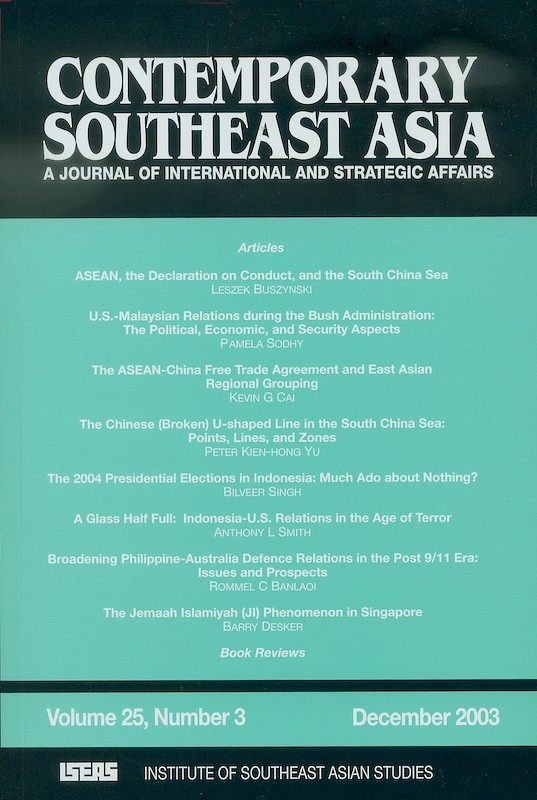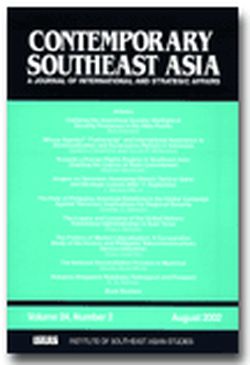Contemporary Southeast Asia: A Journal of International and Strategic Affairs Vol. 25/3 (Dec 2003)

Date of publication:
December 2003
Number of pages:
190
Code:
CS25/3
Contents
-
Contemporary Southeast Asia: A Journal of International and Strategic Affairs Vol. 25/3 (Dec 2003)
-
Preliminary pages
-
ASEAN, the Declaration on Conduct, and the South China Sea, by Leszek Buszynski, author see abstractNorms of behaviour may play a very important role in resolving the South China Sea dispute, and in reducing the potential for conflict. ASEAN and China signed a declaration on conduct for the South China Sea in November 2002, which was the first time that China had accepted a multilateral agreement over the issue. ASEAN had attempted to obtain China's endorsement of international norms of behaviour over the issue since 1992. While China regarded the South China Sea as "lost territories" that were to be restored to the mainland there was little response. China's attitude towards the area changed after the Taiwan crisis of 1995-96 removed from power the main proponents of the recovery of lost territories theme. Moreover, when the Philippines involved the U.S. through the Visiting Forces Agreement of 1998 China realized the value of norms of behaviour in terms of constraining external powers. The article argues that in a situation where a dominant power has a clear advantage over weaker states, a balance of power is required as a prerequisite for the negotiation of norms of behaviour. Without that balance there would be no incentive for that dominant power to accept constraining norms of behaviour. Norms are a product of a balance of power which in this case was provided by the American role.
-
U.S.-Malaysian Relations during the Bush Administration: The Political, Economic, and Security Aspects, by Pamela Sodhy, author see abstractThis article examines the closer and more complex relationship between the US and Malaysia during the Bush Administration and the closing years of the Mahathir administration. This period marked a new stage in their bilateral relationship, one that placed greater emphasis than before on security ties because of the global war on terrorism. The September 11 attacks have significantly impacted the U.S.-Malaysia relationship, especially as Southeast Asia is now viewed as the second front in the war against terrorism. The Introduction of this article provides some historical context for the relationship by noting the state of the relationship towards the end of the Clinton administration. The second part then discusses the closer U.S.-Malaysian relationship on the political level during the Bush administration. The third part examines the steadily growing economic relationship. The fourth part deals with the growing security ties, especially over strategies to fight terrorism, and will stress that security is now the dominant factor in the bilateral relationship.
-
The ASEAN-China Free Trade Agreement and East Asian Regional Grouping, by Kevin G. Cai, author see abstractDespite the growing enthusiasm for a regional economic grouping in East Asia in the wake of the Asian financial crisis, the decision of ASEAN and China to move toward an FTA still came as a major shock to the region and beyond. However, the move is the result of rational calculations by the political leaders of ASEAN and China of possible costs and benefits that such an agreement will bring to both. It also reflects an active response to the intensifying regionalism in the global economy, growing economic ties between the China and ASEAN, and the lessons and aftermath of the Asian financial crisis of 1997-98. The movement of toward an ASEAN-China FTA will also have significant impact on moves toward the formation of a wider East Asian regional grouping.
-
The Chinese (Broken) U-shaped Line in the South China Sea: Points, Lines, and Zones, by Peter Kien-Hong Yu, author see abstractThis article is an attempt to analyse the positive and negative aspects of the Chinese U-shaped line as well as certain points of interest that are more ambivalent in nature. Positive aspects of the line include the observation that the line is not an attempt by both Taipei and Beijing to absorb international boundaries within a national framework. Negative aspects of the line include the burden it creates on the Chinese navy. It also addresses questions such as the nature of the relationship between the U-shaped line and Chinese Communist Exclusive Economic Zones (EEZs), arguing that the non-contradictory relationship must be seen as a form of double insurance that both Taipei and Beijing are investing in.
-
The 2004 Presidential Elections in Indonesia: Much Ado about Nothing?, by Bilveer Singh, author see abstractElectoral reform is important for transitional democracies such as Indonesia, especially when the country has experienced long periods of authoritarian rule with too much power vested in the presidency. The reforms instituted in the post-Suharto period have totally transformed Indonesia. Some observers have argued that the country is moving too fast as evident from continued instability and disorder as well as the proliferation of acts of violence since May 1998. In this regard, the institution of the direct election of the president in 2004 will mark a watershed departure from the past. Yet, at the same time, judging from the political architecture of the country as well as the existence of various political groups and elites, not much change can be expected. Although there has been a proliferation of political activity, the ability of these groups to grab power remains largely limited. To that extent, the new system of electing the president and vice-president is unlikely to lead to a massive change in the power structure for the forseeable future. The incumbent, Megawati Sukarnoputri, will most likely be returned to power with minor changes in the Indonesian political scene.
-
A Glass Half Full: Indonesia-U.S. Relations in the Age of Terror, by Anthony L. Smith, author see abstractThe U.S. may be paying greater attention to Southeast Asia now than at any time since the end of the Vietnam War. Indonesia has assumed some prominence in the war against terrorism, both as a model of moderation in the Muslim world, and as a source of Jemaah Islamiyah (JI)-linked terrorism with presumed connections to Al-Qaeda. While there are examples of substantive cooperation between Indonesia and the U.S. in the war on terrorism, differences remain. The Bush administrations plan to restore military-to-military relations has floundered on objections from Congress. Indonesia has refused to support U.S. military action in Afghanistan and Iraq, while the general public in Indonesia remain distrustful of U.S. foreign policy. While Washington now sees Indonesia as critical to its goals, the relationship is heavily complicated and requires careful management.
-
Broadening Philippine-Australia Defense Relations in the Post 9/11 Era: Issues and Prospects, by Rommel C Banlaoi, author see abstractThe Philippines and Australia have a strong history of diplomatic and economic relations. Yet, their defense relations are still weak. Although the 1995 Defense Cooperation Agreement has provided the two countries a framework to cooperate closely on defense matters, the scope of their cooperation is still confined to confidence-building measures. There is a need to broaden their defense relations in the light of their mutual recognition of strategic interests in regional security, particularly in the context of the war on terrorism in Southeast Asia. Strong Philippine-Australia defense relations will expand the web of bilateral defense relations of like-minded states in the Asia Pacific to foster regional peace and stability. The Philippines and Australia have a strong potential for being a defense partners in regional security by virtue of geographic proximity and cultural familiarity. But the glue that could help bond the two countries more closely is their shared regional security perspective.
-
The Jemaah Islamiyah (JI) Phenomenon in Singapore, by Barry Desker, author see abstractRecent publicity over the trials in Indonesia of Jemaah Islamiyah (JI) members has again brought the spotlight onto this elusive group and their operations around the region. This article begins by tracing the global and regional roots of the organization from conflict in the Middle East to the Iranian Revolution and the Soviet Afghan War. These events have contributed to the remarkable success of Osama bin Laden, his Al-Qaeda network and the call to Islamic jihad, all achieved by harnessing Muslim extremist forces to coincide with the zeitgeist of increasing religious orthodoxy and the politicization of the ummah. Links are drawn between the Al-Qaeda and JI networks, as well as with other regional groups. The radicalization of Islam in Southeast Asia is depicted as not such a recent phenomenon, but an evolution of political, social and educational practices across the region. Progressive and inclusive States like Singapore are not immune to the JIs insidious presence they can only hope to reduce the ongoing terrorist threat through robust security measures and effective public policies which incorporate education and dialogue with the Muslim leaders and the wider Islamic community.
- BOOK REVIEWS
-
BOOK REVIEW: Regional Security Structures in Asia. By Ashok Kapur., by Ralf Emmers, author
-
BOOK REVIEW: The Political Economy of Cambodia's Transition, 1991-2001. By Caroline Hughes, by Ruhanas Harun, author
-
BOOK REVIEW: Burma's Armed Forces: Power without Glory. By Andrew Selth, by Tin Maung Maung Than, author
-
BOOK REVIEW: India as an Emerging Power. Edited by Sumit Ganguly, by Baladas Ghoshal, author
-
BOOK REVIEW: Media and Politics in Pacific Asia. By Duncan McCargo, by Susan A. Hellweg, author
-
BOOK REVIEW: The Power of Institutions: Political Architecture and Governance. By Andrew McIntyre, by Lawrence J. LeBlanc, author




